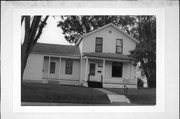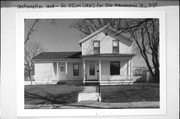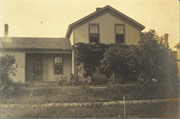Property Record
526 MENOMONIE ST
Architecture and History Inventory
| Historic Name: | ADIN RANDALL HOUSE |
|---|---|
| Other Name: | RANDALL-FARREL HOUSE |
| Contributing: | |
| Reference Number: | 442 |
| Location (Address): | 526 MENOMONIE ST |
|---|---|
| County: | Eau Claire |
| City: | Eau Claire |
| Township/Village: | |
| Unincorporated Community: | |
| Town: | |
| Range: | |
| Direction: | |
| Section: | |
| Quarter Section: | |
| Quarter/Quarter Section: |
| Year Built: | 1862 |
|---|---|
| Additions: | |
| Survey Date: | 1981 |
| Historic Use: | house |
| Architectural Style: | Gabled Ell |
| Structural System: | Balloon Frame |
| Wall Material: | Clapboard |
| Architect: | |
| Other Buildings On Site: | |
| Demolished?: | No |
| Demolished Date: |
| National/State Register Listing Name: | Randall, Adin, House |
|---|---|
| National Register Listing Date: | 1/28/1983 |
| State Register Listing Date: | 1/1/1989 |
| National Register Multiple Property Name: | Multiple Resources of Eau Claire |
| Additional Information: | The Randall house, located on the Chippewa River, not far from where Randall constructed his mill, is a simple frame structure composed of a one and a half story section and a one story wing. Gable roofs cover both parts of the home which is sided with clapboards. A veranda supported by Tuscan columns stretches across the main section, while an inset porch characterizes the wing. The building is in excellent condition. The Adin Randall house is historically significant because of its association with Adin Randall, one of Eau Claire's original settlers and its first "booster", who actively and enthusistically promoted the community's natural advantages as a lumber center. He platted a large portion of the city's east side and was instrumental in convincing a number of eastern lumbermen to relocate at the river junction. Randall himself was involved in a number of commercial ventures, including the operation of a small planing mill and the ferry across the Chippewa River. Randall also served as Eau Claire county's first treasurer (C). Within Eau Claire, Randall is memorialized by a school, a park, and a statue. Although these structures/sites are fine tributes to an early poioneer, Randall's contribution to the city's history is best represented by his home. Born in Clarksville, New York, in 1829, Adin Randall came to Wisconin in 1854, settling in its capital city, where he worked as a builder and contractor. A year later he moved to Eau Claire and undertook the construction of a hotel, the Eau Claire House, which he completed in 1856. Also in 1856, Randall platted a large area on the west side of the Chippewa River and named it Eau Claire City. Within the plat he included land for a park (named Randall Park in 1876) and a cemetery. He later donated land to the First Congregational Church (see Randall Park Historic District). At the sam etime the energetic Randall persuaded easterners Daniel Shaw and Alexander Dole, the financial partner of O.H. Ingram (the Dole and Ingram partnership was the forerunner of the Empire Lumber Company), to invest in the new region with its seemingly limitless timber resources. A further inducement was the natural log storage facility available in Half Moon Lake, a former ox box of the Chippewa River bordering Randall's plat and other lands he owned on the river. Shaw established his company at the lake's outlet and Dole and Ingram purchased land from Randall and set up operations between Half Moon Lake and the Chippewa River. Randall's own sawmill was located east of Dole and Ingram's land at the foot of what is today Ninth Avenue (D). To take advantage of Half Moon Lake's potential, Daniel Shaw, Randall, and Jotham Clark, another early lumberman, contracted to dig canals from the river to the lake (this canal would be located near Randall's mill) and from the outlet of the lake to the river (Shaw's property, as noted above, was located at the outlet). The first canal completed in 1857-58 but lacking additional capital for the second canal, Shaw, Randall, and Shaw's brother-in-law, C.A. Bullen (he replaced Clark), incorporated the Half Moon Lake Canal Company in 1859. Using the investments of other lumbermen, who, in return, would have access to the lake, the entire project was completed within ten years at a cost of nearly $35,000. (E) To simplify the channeling of logs, Randall invented the sheer boom. This device used the force of the river to divert logs into Half Moon Lake, drastically cutting losses during floods. Despite this picture of progress, Randall's ambitious plans suffered a number of setbacks. First, the land he had sold to Dole and Ingram and to other had a mortgage on it. Quite reasonably, the purchasers were angry and many, including Ingram, Dole, and their third partner, Kennedy, stayed clear of the enterprising real estate promoter (D). Even more devastating was the Panic of 1857. Randall, overextended in a number of areas, sold his mill in 1869 and, hoping for better luck, established mills in Chippewa Falls, Jim Falls, and Reed's Landing on the Mississippi. Randall died at Reed's Landing in 1868 at the age of 39. Thomas E. Randall, a Chippewa Valley historian, provided an interesting description of Eau Claire's first "booster": "A strange composition of reckless energy, of daring and enterprise, with a want of punctuality and an adaptation of means to ends, was this same Adin Randall; with many good business traits he lacked some element of success that made him always unsafe, and lost to him the confidence of the business community." (F) 2016- "Adin Randall, one of Eau Claire's first settlers and boosters, enthusiastically promoted the community's advantages as a lumber center. This typically modest 1860s house was built near his small sash and door factory and planning mill, located on the Chippewa River at the foot of Ninth Avwenue. Randall operated an early ferry across the Chippewa River, providing a link with settlers in the downtown area. Along with other lumbermen, he developed the natural log storage facility available in Half Moon Lake. To simplify the channeling of logs, Randall invented the shear boom, a remarkable device that used the force of the river to divert logs into Half Moon Lake, drastically cutting losses during floods. Old pilings from the boom can be seen behind Hobb's Ice Arena when the river is low." -"Eau Claire Landmarks: Designated Historic Properties in Eau Claire, Wisconsin", Eau Claire Landmarks Commission, P.O. Box 5148, 2016. |
|---|---|
| Bibliographic References: | (A)EAU CLAIRE LANDMARKS COMMISSION, 1977, SELF GUIDED TOUR OF THE SAWDUST CITY, #25. (B) ADIN RANDALL MANUSCRIPT, CHIPPEWA VALLEY MUSEUM, ND, PROBABLY BY MARSHALL COUSINS. (C) HISTORY OF EAU CLAIRE CO., 1914, PP. 839-842. (D) TWINING, C. 1975 DOWN RIVER, PP. 25-26, 45. (E) REYNOLDS, AR. 1957, THE DANIEL SHAW LUMBER CO. PP. 79-80. (F) RANDALL, T. 1875 HISTORY OF THE CHIPPEWA VALLEY, PP. 55-5? Eau Claire Landmarks booklet published by the Landmarks Commission in 2002. |
| Wisconsin Architecture and History Inventory, State Historic Preservation Office, Wisconsin Historical Society, Madison, Wisconsin |



